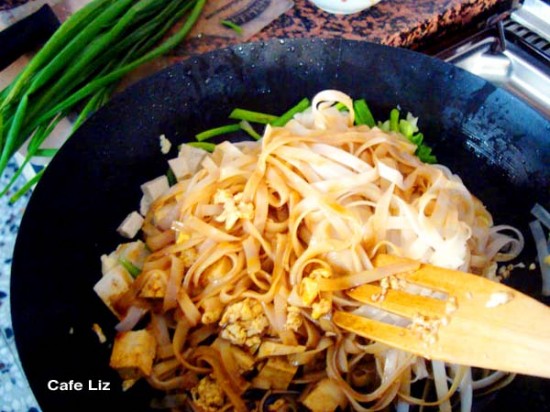When I discovered the Thai House‘s recipe for pad thai, I felt like I was discovering the dish anew — with a sauce of only soy sauce and sugar, this recipe was amazingly simple, produced way better results than any other pad thai I had ever made in the past, and tasted great. In fact, the pad thai I was making at home was so good that I didn’t even bother to order the dish on my first few days in Thailand — after all, I knew how pad thai was supposed to taste, so I might as well try other things, right?
So I was all the more surprised once I finally got around to trying the Thai version of “Thai stir-fry” to discover just how different it was from what I made at home. In retrospect, it makes perfect sense that Israeli pad thai is made from ingredients available locally, while the Thai version has a base of fish and oyster sauce, and often contains garlic chives, bean sprouts, different kinds of Thai tofu, shallots (I’d put shallots in everything, too, if I could get them for 50 agorot a kilo), Thai garlic (sweeter than the garlic we use in the West), tamarind, lime juice, palm sugar and shrimp.
OK, so maybe this version isn’t authentic, but it brings rave reviews and recipe requests whenever I make it, and it quickly became one of my (and my friends’) staples. Plus, you can expand on the basic concept to add some more “Thai” ingredients, if you can find them.

Regardless of what vegetables and sauces you decide to put in your pad thai, the secret to perfect rice noodles lies in letting them soak for an hour or two before you cook them. The soaked noodles are pulled from the water and thrown straight into the wok, where they cook in a matter of minutes — no boiling involved.
And a little comment about portion size, given the current discussion about how recipe portions have been getting larger (and more caloric) over the past several decades. Not surprisingly, recipe portion sizes vary by culture, too. The Israeli recipe states that 100 grams of noodles, 50 grams tofu and an egg is a serving, while a recipe I learned in Thailand says that 50 grams noodles, 20 grams tofu and 1 egg is one serving. Interesting.
For 2-3 servings:
200 grams rice noodles (or one 300 gram bag bean-thread noodles)
100 grams tofu, cubed
half a box of mung bean sprouts (or a few generous handfuls)
1-2 eggs
1 bunch of green onions, roughly chopped
30 grams chopped roasted peanuts (optional)
3 tablespoons oil
1/2 cup soy sauce
2 tablespoons sugar
To make it more Thai, you can add to the stir-fry:
- chopped garlic
- garlic chives (possibly in place of green onions)
And to your sauce you can add:
- 3 tablespoons (mushroom-based) oyster sauce
- 1 teaspoon fish sauce (this isn’t vegetarian, but you can find kosher fish sauce made from anchovies)
- 2 tablespoons tamarind
Note: Use less soy sauce if you add oyster or fish sauce.
Optional toppings:
- lime/lemon juice
- red pepper flakes
Set the noodles to soak about an hour in advance (half an hour for bean thread noodles).
Heat the oil in a wok. Scramble the eggs, then add the tofu (and optional garlic) and let brown for a minute. Add the noodles (without the water), and stir, letting the noodles begin to soften. Add the sauce (the soy, sugar, and optional oyster sauce, fish sauce and tamarind), and mix well, so that the noodles are coated. Toss in the bean sprouts and the chopped green onions (and the optional garlic chives), and stir for another minute.
Serve. Toppings of your choice include a squeeze of lemon/lime juice, extra fish sauce, peanuts and red pepper flakes.






